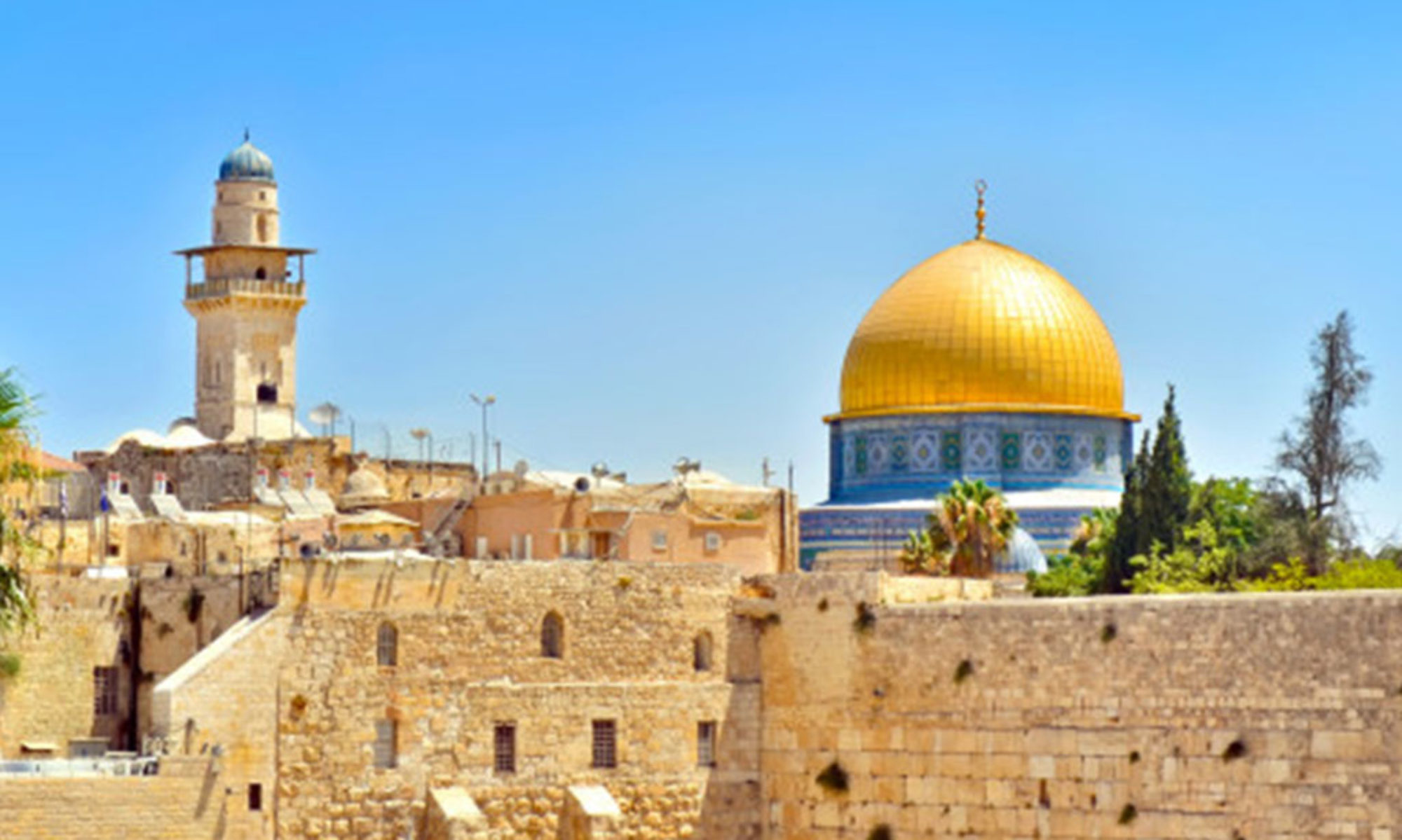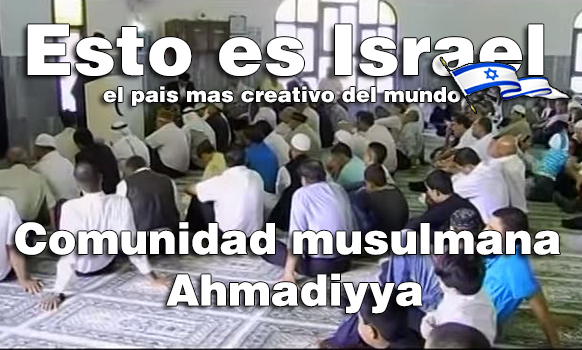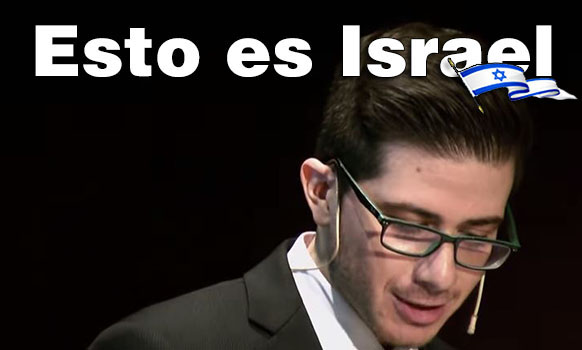strangers (2004)- short film by: Erez Tadmor & Guy Nattiv
Las pastelerias de Haifa | הקונדיטוריות בחיפה
Israel21.com
Stav Shaffir: Que es sionismo?
Stav Shaffir, la miembro de la Knesset mas joven de la historia (29 años) (partido «Avoda»).
Not yet 30, Israel’s youngest lawmaker is already a legend
Video of Stav Shaffir’s impromptu ‘Who Is a Zionist’ speech goes viral after social justice activist catapults to No. 2 spot in Labor primary.
By Judy Maltz | Feb. 2, 2015 | 4:29 PM
She had once dreamed of becoming an astronaut. Later on, it was music that beckoned. In between, she dabbled in journalism and community service.
But a career in politics was never quite on the agenda. And certainly never in her wildest dreams did Stav Shaffir of Isael’s Labor Party imagine that by this stage in her life she would have achieved something verging on political stardom.
It’s not just the big messy mane of red hair that distinguishes this high-energy lawmaker from her Knesset colleagues, who often refer to her as the gingit, Hebrew for “redhead.” At 29, Shaffir is the youngest member of the outgoing Knesset and the youngest woman ever to serve as an Israeli lawmaker. If Zionist Camp ends up forming the next government, which recent opinion polls indicate is a distinct possibility, she could very well become the youngest woman ever to sit in the Israeli cabinet.
An impassioned address Shaffir recently delivered in the Knesset is sure to go down as one of the big moments of the 2015 election campaign. Barely a handful of Knesset members were present when Shaffir took the podium, but the YouTube video of her three-minute speech — which has become popularly known as the “Who Is a Zionist” speech — became an immediate sensation on social media.
Accusing the political right of misappropriating public funds to serve its own interests, and particularly those of its settler supporters, she cried: “Don’t preach to us about Zionism, because real Zionism means dividing the budget equally among all the citizens of the country. Real Zionism is taking care of the weak. Real Zionism is solidarity, not only in battle but in everyday life.”
Shaffir’s comments were an unplanned response to statements made by the head of the religious right-wing Habayit Hayehudi party, Naftali Bennett, she told Haaretz this week. “It was completely improvised,” she said. “We had come to the Knesset to vote on raising the minimum wage, when Naftali Bennett got up and started attacking my party. It made me really angry, and I decided I had to respond.”
The fact that the video of that impromptu speech went viral, said Shaffir, proves to her that “the Israeli public yearns for politics of hope and is sick of the politics of despair.”
That was little more than a week after Shaffir proved her overwhelming popularity within the party. She placed No. 2 in the January 14 Labor primary, giving her the fourth spot on the Zionist Camp ticket, the joint slate merging Isaac Herzog’s Labor with Tzipi Livni’s Hatnuah — just one rung below Herzog, Livni and former party chairwoman Shelly Yacimovich.
Young blood
It was just over two years ago that Shaffir embarked on her political career. The Labor party was anxious to bring in some young blood, and Shaffir, with her credentials as an outspoken leader of the summer 2011 social justice movement, was seen as a candidate who could attract young voters. Few expected her to serve more than an ornamental function in her first term in the Knesset, or to learn the ropes of parliamentary life as quickly as she did.
Her opponents tend to pooh-pooh Shaffir as a loud-mouthed attention seeker with a penchant for provocation, especially when television cameras are around. But that doesn’t mean it’s been all talk and no action.
Ever since being sworn in two years ago, Shaffir has focused her energies on using her seat in the powerful Knesset Finance Committee to fight for greater budget oversight. As a newcomer to the system, she says she was shocked to discover how many millions of shekels are transferred from one item to another in the secret budget deals among political parties and interest groups, of which the public has little, if any, knowledge. The main targets of her wrath have been the defense establishment and the settler movement, both key beneficiaries of this lack of transparency.
“I was absolutely horrified,” she said in a recent interview with Haaretz. “I couldn’t believe things like this happen. All these deals are being made, and nobody understands what’s going on except for the chairman of the committee and the treasury officials. Most Israelis have no idea where their money is going. They pay lots of taxes, but many of the details of the budget are concealed from them. For example, how much money goes to [the northern border town of] Kiryat Shmona compared to how much goes to [the West Bank settlement of] Hebron, or how much goes to education versus how much goes to defense.”
As a stopgap measure, Shaffir began with filibusters, driving her political opponents mad with endless questions about each budgetary transfer. Then she recruited a staff of volunteers through Facebook to begin investigating every transfer — finding out where the money came from and where it was going, and then posting the findings on her Facebook page.
“Because the treasury tends to refuse to answer a lot of these questions, we decided to look into it ourselves,” she said.
The pressure worked. The treasury eventually broke down and agreed to publish information online on budgetary transfer requests several days before the Knesset Finance Committee was asked to vote on them, rather than on the spot, as had long been the norm — giving its members time to make informed decisions.
In December 2013, Shaffir went a step further when she petitioned the Supreme Court against the treasury and the Knesset Finance Committee for authorizing hundreds of millions of shekels of changes in the budget without the approval of the full Knesset and the cabinet.
Shaffir’s daily altercations with Nissan Slomiansky, the chairman of the Knesset Finance Committee and a member of Habayit Hayehudi, have become legendary — so much so that a recent cartoon in Haaretz had her thanking Slomiansky with a bouquet of flowers after her impressive showing in the Labor primary.
Not long before new elections were called in December, the Knesset Finance Committee was about to convene for its daily session, with Shaffir already poised for action, banging away on her laptop. Within minutes, she was lashing out at Slomiansky, seated at the head of the table, for authorizing yet another handout to an organization affiliated with the settler movement. As the scene played out, the two of them wagging their fingers at one another, Shaffir continued updating her followers in real time via Twitter and Facebook.
In between, she dashed over to a rather unlikely ally on the committee: Moshe Gafni, of the ultra-Orthodox United Torah Judaism party, who has previously served as its chairman. The two exchanged a few words in low voices and planned their strategy for undermining Slomiansky.
A committee member representing the ruling Likud, who asked not to be quoted by name, had this to say about the young Labor lawmaker, as he observed the scene: “She’s doing a fabulous job, and I wish there were more like her, but I really wonder if she would behave had she been representing the coalition rather than the opposition.”
‘It all comes down to the budget’
Born in the coastal town of Netanya, Shaffir grew up in Pardesiya, a small community in the central Sharon region. Her father was an accountant, and her mother a teacher who later joined her husband in the family business. Shaffir, the oldest of three children, has an autistic sister. Before joining the army, she spent a year working with underprivileged children in Tiberias.
Her dream was to become fighter pilot in the air force. But she didn’t make it through flight school and eventually transferred to Bamahaneh, the IDF magazine, where she served as a reporter for the remainder of her service, covering Israel’s 2005 withdrawal from Gaza and the Second Lebanon War in 2006. She went on to study sociology, journalism and music.
After completing her military service, Shaffir received a scholarship to City University London, where she participated in a special program to promote dialogue among future Israeli and Palestinian leaders and earned a bachelor’s degree in sociology and journalism. Upon returning to Israel, Shaffir, who plays the piano, drums, guitar, violin and oud,enrolled in the Rimon School of Jazz and Contemporary Music. Before embarking on her political career, she worked as a reporter and editor at various Israeli publications.
Despite not having any background in economics or finance, Shaffir, who lives in Tel Aviv, made a conscious decision her first day in the Knesset to immerse herself in money matters. “In the end, it all comes down to the budget,” she said. “How the budget is allocated determines whether there is equality and social justice in this country.”
What would be her dream job in politics? “Mostly I’m interested in a position that would allow me to influence prices in the housing market,” said Shaffir. “Any job that would allow me to implement policy in that area would be great.”
Fuente: Haaretz
Circasianos de Kfar Kama, Israel | העדה הצ’רקסית בכפר קמה
Circasianos en Kfar Kama, Israel
Los circasianos israelíes han tenido buenas relaciones con la comunidad judía en Israel desde el comienzo del asentamiento judío en la Tierra de Israel, en parte debido al lenguaje compartido con muchos de los primeros inmigrantes de Aliyah de Rusia que se establecieron en Galilea. La comunidad circasiana en Israel ayudó a la migración (Ha’apala) de judíos del Líbano al Mandato de Palestina y luchó en el lado israelí de la Guerra de la Independencia.
Como es el caso con los judíos israelíes y los grupos drusos israelíes que viven en el estado de Israel (excepto la población drusa que vive en los Altos del Golán), desde 1958 todos los circasianos hombres (a petición de su líder) deben completar el ejército obligatorio israelí. servicio al llegar a la mayoría de edad, mientras que las mujeres no lo hacen. Muchos circasianos en Israel están empleados en las fuerzas de seguridad israelíes, incluso en la policía de fronteras israelí, las fuerzas de defensa israelíes, la policía israelí y el servicio penitenciario israelí. El porcentaje de reclutas del ejército entre la comunidad circasiana en Israel es particularmente alto.
Comunidad Musulmana Ahmadía en Israel | העדה המוסלמית-אחמדיה
Comunidad Musulmana Ahmadía
El Movimiento Ahmadía del islam fue fundado por Mirza Ghulam Ahmad (1835, 1908 de Qadian) el 23 de marzo de 1889 en la India. Sus elementos doctrinales incluyen polémicas declaraciones de su fundador como que él era el Mesías profetizado por las religiones monoteístas (el Emanuel judío, la segunda venida de Cristo y el Mahdi islámico), así como su declaración de que Jesús no murió en la cruz ni fue resucitado, sino que sobrevivió y siguió predicando en busca de las tribus perdidas de Israel hasta llegar a India donde predicó entre los budistas y su tumba se encuentra en Cachemira.
Los musulmanes ahmadía forman, de acuerdo a su propia opinión, un movimiento reformado dentro del islam, reflexionando sobre la esencia de esta religión. Los musulmanes ahmadía se separan claramente de los grupos militantes y fundamentalistas destacando los elementos pacíficos y tolerantes del islam. No obstante, la gran mayoría de los musulmanes tradicionales consideran que el movimiento ahmadí es apóstata y hereje y que no forma parte del islam. La Liga Mundial Islámica declaró en su conferencia anual de 1974 que los ahmadí no eran musulmanes. Debido a esto los ahmadí han sufrido graves casos de persecución religiosa en muchos países, principalmente en Pakistán donde tiene prohibido predicar, declararse públicamente como musulmanes, orar en público ó en mezquitas no ahmadíes, etc. Se han reportado ataques violentos contra ahamadíes en Pakistán, Bangladés e Indonesia.
Esta rama del Islam se fraccionó en 1914 en la Ahmadiyya Muslim Yamat (AMJ) y la Lahore Ahmadiyya Movimiento (Ahmadiyya Anjuman Ishaat-i-Islam Lahore, AAIIL). Esta última fracción Lahore Ahmadiyya Movimiento (Ahmadiyya Anjuman Ishaat-i-Islam Lahore, AAIIL) ha quedado disminuida considerablemente al no tener éxito, el 80% de los miembros de esa rama cambiaron de bando a (AMJ) que actualmente son alrededor de 300 millones repartidos en más de 200 países.
El Jefe Supremo de la Comunidad Internacional Ahmadía del Islam es Jalifatul V. Mirza Masrur Ahmad desde el 22 de abril de 2003.
Ahmad afirmó ser el Reformador esperado de los últimos días, el Esperado por todas las comunidades religiosas del mundo el Mahdi y el Mesías. El Movimiento que inició es un compendio del mensaje conciliador del Islam: paz, hermandad universal y sumisión a la Voluntad de Dios, en su pureza original. Ahmad apuntó a que era él el Mesías prometido y señaló los errores de la mayoría de los musulmanes y de como se habían alejado de las verdaderas enseñanzas del Islam, por lo que la mayoría de los musulmanes consideran a los ahmadíes como herejes y no musulmanes.
Otra posición que los hace controvertidos es que Ahmad y sus seguidores creen que Jesús no murió en la cruz ni resucitó sino que siguió con su misión en predicar a las tribus perdidas de la Casa de Israel tal como indicaban las profecias del Antiguo Testamento. La última de esta tribu se encontraba en Cachemira, norte de la India, en donde aseguró que muchos monjes budistas eran judíos (todo esto publicado en su libro Jesús en la India). Ahmad adujo haberse basado en investigaciones de los Evangelios, el Corán y textos budistas para sus declaraciones y que la tumba de Jesús (quien murió a la edad de 120 años) se encuentra en Cachemira.
También es parte de la doctrina ahmadí que las tribus de Gog y Magog profetizadas en el Apocalipsis son los modernos cristianos y los modernos musulmanes ortodoxos.2
El Jalifato Ahmadía
El Jalifatul Masih (sucesor del Mesías Prometido) es el Jefe Supremo de la Comunidad Ahmadía. Es elegido por el colegio electoral establecido para este propósito. Sin embargo, los áhmadis musulmanes creen firmemente que es Al-lah quien elige al Jalifa, como hizo con el Califato Rashidun; pues cada vez que tiene lugar la elección de un Jalifa, el corazón y la mente de los electores se inclinan hacia la misma persona. Esta creencia aumenta aún más el sentido de paz y seguridad que el Jalifa otorga a la Comunidad. Cuando se elige a un Jalifa, todos los hombres, mujeres y niños de la Comunidad deben mostrarle una completa obediencia y reafirmar el Bai’at con él.
La presencia del Jalifa es una gran bendición de Dios para la Comunidad. Él es el líder y padre espiritual para cada áhmadi y una fuente de luz que guía a cada miembro de la comunidad. Siempre que el Jalifa elabora un plan o esquema para la Comunidad, lo hace a través de la dirección y asistencia divinas. Se preocupa del bienestar de cada miembro de la Comunidad y reza por ellos. En momentos de dificultad o enfermedad, los áhmadis escriben a menudo al Jalifa para que implore por ellos, quienes perciben un alivio inmediato de sus tribulaciones.
Persecución en Pakistán
Hoy en día la comunidad Ahmadía del Islam está perseguida en Pakistán por parte del gobierno y sus habitantes. También son perseguidos en los países musulmanes donde carecen de libertad de culto. El motivo de la persecución es la afirmación que hacen sobre la muerte de Jesús en Cachemira y creen en Hazrat Mirza Ghulam Ahmad, como el Mesías Prometido y el Imam Mahdi.
Comunidad Ahmadía del Islam en Europa
En 1913 la primera misión islámica fue establecida en Woking (cerca de Londres). En 1922 la fracción AAIIL construyó la primera mezquita de Alemania en Berlín. La fracción AMJ construyó la primera mezquita después de la II Guerra Mundial en Hamburgo en 1957. La sede de la AMJ fue trasladada de Rabwah a Londres por represiones a la religión en Pakistán. El 4°. califa ahmadía, Mirza Tahir Ahmad, residió en la mezquita Al-Fazl.3 En 2003 fue inaugurada Baitul Futuh, una mezquita en la que caben en la sala central unas 4.500 personas, mientras que en el edificio total pueden llegar a 10.000 personas.4
Comunidad Ahmadía del Islam en España
El primer misionero que llegó a España fue de la India, Maulana Karam Ilahi Zafar, llegó el 24 de junio de 1946 y la Mezquita Basharat, construida en 1982 en Pedro Abad (provincia de Córdoba) es la primera Mezquita de España construida después de siete siglos. La segunda mezquita se encuentra en la Pobla de Ballbona (Valencia) y fue inaugurada por el Jalifa del Islam en marzo del 2013.
Fuente: Wikipedia
La historia de mi familia, escapando Jaffa, construyendo un futuro en Israel
George Deek, árabe, cristiano, es el vice embajador de Israel en Noruega.
Published on Oct 1, 2014
Topic: «My family’s story in 1948 – fleeing Jaffa, building a future in Israel.»
George Deek, Israel’s vice ambassador to Norway, giving a lecture in the House of Litterature in Oslo, during a MIFF event 27 September 2014.








